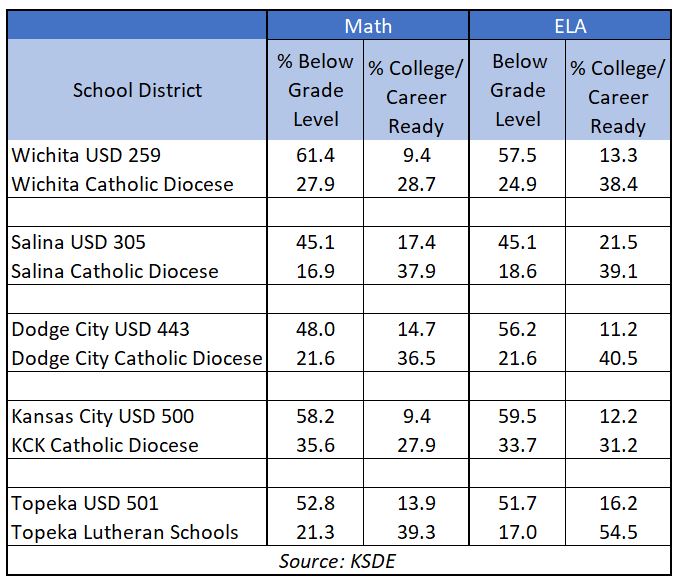With the 2023 National School Choice Week upon us, it is the perfect time to show that once again in Kansas low-income students in private schools outperform low-income students in public schools. Data from KSDE indicates for the 2022 state assessments private school students are more college/career ready on the Kansas state assessment than those in public schools, particularly in Kansas’s urban areas.
The table below shows the stark differences between how low-income students in parochial and public districts do on the 2022 Kansas state assessments in Wichita, Kansas City, Dodge City, Salina and Topeka. Students in each diocese (plus Topeka Lutheran) not only score much higher than those in public districts, each exceeds the state averages in both math and English language arts (ELA).
Dr. Jamie Finkeldei, Associate Superintendent of the Catholic Diocese of Wichita, puts it this way: “Not only do our free/reduced lunch students score dramatically better than the state average for free/reduced lunch students, but our free/reduced lunch students slightly outperform the state average of all students. It is clear that free/reduced lunch students will do better if enrolled in our schools. Our schools benefit all students, but actually benefit free/reduced lunch students even more than our other students.”
The adjoining table shows the top 25 ranked individual schools for low-income student overall performance on the 2022 state assessments. Fourteen of the top 25 are private schools- led by St. Dominic Elementary of Garden City – despite the fact that only 121 of the state’s approximately 1,400 tested schools are private.
Fourteen of the top 25 are private schools- led by St. Dominic Elementary of Garden City – despite the fact that only 121 of the state’s approximately 1,400 tested schools are private.
It’s like the broken record cliché, another year of state assessments, another year of evidence that private schools outperform public schools, and another year that most Kansas students continue to be stuck in underperforming schools.
Consider this: last school year the state set a record for the lowest percentage of school spending on instruction. Simultaneously, scores for Kansas students on the 2022 NAEP exam dropped more than virtually any other state. Kansas students now score below the national average on virtually every NAEP measure. Coincidence?
These realities continue to beg the question: Will Kansas have the political will to wake up and address these issues, or will it be status quo?
It’s time to put students first, not the institution.





